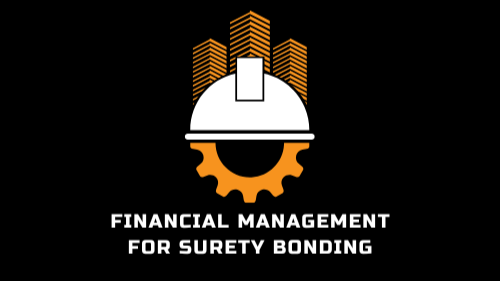
1. 𝑭𝒊𝒏𝒂𝒏𝒄𝒊𝒂𝒍 𝑺𝒕𝒂𝒕𝒆𝒎𝒆𝒏𝒕 𝑨𝒄𝒄𝒖𝒓𝒂𝒄𝒚 𝒂𝒏𝒅 𝑷𝒓𝒆𝒔𝒆𝒏𝒕𝒂𝒕𝒊𝒐𝒏
Sureties rely on accurate, transparent, and consistent financial statements to evaluate a contractor’s financial health. The key elements include:
👷🏾Work-in-Progress (WIP) Reporting
- 🔨 The WIP schedule provides insights into project profitability, backlog, and billing status.
- 🔨 It includes the contract price, estimated cost, costs incurred to date, billings, and revenue recognized.
- 🔨 Sureties assess whether contractors understate costs or overstate revenue, which can distort financial stability.
- Percentage of Completion Method (PCM) vs. Completed Contract Method (CCM)
- 📐PCM is preferred because it matches revenue and expenses to work completed, offering real-time financial insights.
- 📐CCM is riskier for sureties as it defers revenue and expenses until project completion, leading to financial volatility.
- Over- and Under-Billings
- 📐Over-billings (billing more than work completed) temporarily boost cash flow but create future liability.
- 📐Under-billings (billing less than work completed) indicate poor billing practices and potential cash flow problems
2. 𝐉𝐨𝐛 𝐂𝐨𝐬𝐭𝐢𝐧𝐠 𝐚𝐧𝐝 𝐂𝐨𝐬𝐭 𝐂𝐨𝐧𝐭𝐫𝐨𝐥
A robust job costing system is critical for accurate financial reporting and cost control:
👷🏾Detailed Cost Tracking
- 📐 Proper tracking of labor, materials, subcontractors, equipment, and overhead on a per-job basis.
- 📐Helps determine whether projects are within budget and profitable.
- Cost-to-Complete Projections
- 📐 Sureties analyze the accuracy of cost-to-complete estimates to assess whether the contractor has adequate resources to finish projects.
- Indirect Cost Allocation
- 📐 Proper distribution of overhead costs (e.g., administrative expenses, insurance, and rent) across projects ensures accurate financial reporting.
3. 𝐑𝐞𝐭𝐚𝐢𝐧𝐚𝐠𝐞 𝐚𝐧𝐝 𝐂𝐚𝐬𝐡 𝐅𝐥𝐨𝐰 𝐌𝐚𝐧𝐚𝐠𝐞𝐦𝐞𝐧𝐭
👷🏾 Retainage is the percentage of progress payments withheld until project completion, impacting cash flow and liquidity.
- ✅Managing Retainage Receivables
- 📐Retainage should be classified separately in financial statements to reflect its impact on cash flow.
- 📐 Excessive retainage receivables indicate potential cash flow stress.
- ✅Liquidity and Working Capital
- 📐 Sureties prefer contractors with sufficient working capital (current assets – current liabilities) to cover short-term obligations.
- 📐A low current ratio (< 1.2) or poor liquidity raises red flags.
4. 𝐃𝐞𝐛𝐭 𝐚𝐧𝐝 𝐋𝐞𝐯𝐞𝐫𝐚𝐠𝐞 𝐂𝐨𝐧𝐬𝐢𝐝𝐞𝐫𝐚𝐭𝐢𝐨𝐧𝐬
👷🏾 Excessive debt can put a contractor at financial risk and impact bonding capacity.
- ✅Debt-to-Equity Ratio
- 📐A ratio above 3:1 is a concern for sureties.
- 📐 A healthy ratio indicates financial stability and the ability to withstand economic downturns.
- ✅Line of Credit (LOC) Availability: Sureties review whether a contractor has an unused LOC as a financial cushion. Over-reliance on short-term debt signals financial instability.
5. 𝐁𝐨𝐧𝐝𝐢𝐧𝐠 𝐂𝐚𝐩𝐚𝐜𝐢𝐭𝐲 𝐚𝐧𝐝 𝐅𝐢𝐧𝐚𝐧𝐜𝐢𝐚𝐥 𝐑𝐚𝐭𝐢𝐨𝐬
👷🏾 Sureties set bonding limits based on financial strength. Key financial ratios include:
- ✅Working Capital to Backlog Ratio
- 📐 Measures financial capacity to support projects.
- 📐Ideally, at least 10-15% of backlog value should be available in working capital.
- ✅Gross Profit Margin
- 📐Indicates project profitability.
- 📐A declining trend may suggest weak bidding strategies or cost overruns.
- ✅Return on Equity (ROE)
- 📐Shows profitability relative to net worth.
- 📐A low ROE may indicate underperformance.
6. 𝐂𝐡𝐚𝐧𝐠𝐞 𝐎𝐫𝐝𝐞𝐫 𝐌𝐚𝐧𝐚𝐠𝐞𝐦𝐞𝐧𝐭
👷🏾Poor management of change orders can lead to disputes and financial strain.
- Approved vs. Unapproved Change Orders: Approved change orders should be recorded in financial statements immediately. Unapproved or disputed change orders are not considered reliable revenue by sureties.
- Impact on Profitability: Large outstanding change orders may inflate revenue, misleading sureties about actual financial health.
7. Claims and Contingencies
👷🏾Legal claims and disputes affect a contractor’s financial standing and bonding capacity.
- Pending Legal Claims: Sureties assess whether the contractor is involved in litigation that could lead to financial loss. High-value claims indicate operational risk.
- Warranty Reserves: Contractors should maintain reserves for potential warranty costs post-project completion. Lack of reserves suggests poor financial planning.
8. Tax Planning and Compliance
👷🏾Sureties review tax liabilities to assess financial obligations.
- Deferred Tax Liabilities: Some contractors defer taxes using accelerated depreciation, impacting reported net worth. Excessive deferrals may reduce the credibility of financial statements.
- Tax Compliance Risk: Unpaid or overdue taxes raise concerns about financial mismanagement. Sureties prefer contractors with a clear tax strategy.
9. Audit and Review Levels
👷🏾Sureties prefer CPA-reviewed or audited financial statements over internally prepared statements.
- Audit vs. Review vs. Compilation
- Audited Statements: Most reliable; required for high bonding limits.
- Reviewed Statements: Provides some assurance but lacks full verification.
- Compiled Statements: Least reliable; often insufficient for bonding.
- GAAP or Construction-Specific Accounting Methods: Sureties prefer compliance with GAAP or industry standards (e.g., ASC 606 for revenue recognition).
10. Contractor Experience and Business Continuity
👷🏾A contractor’s financial health is also influenced by management experience and long-term planning.
- Key Personnel and Financial Acumen: Experienced management teams with strong financial controls increase bonding confidence. Frequent management turnover is a red flag.
- Succession Planning and Business Continuity: Sureties prefer contractors with a clear succession plan to ensure business stability in case of leadership changes. Lack of continuity planning increases financial risk.
Final Thoughts
From a surety bonding perspective, construction accounting should focus on financial accuracy, liquidity, job costing, and risk management. Contractors seeking bonding should prioritize:
✅ Strong WIP reporting and revenue recognition practices.
✅ Healthy working capital and cash flow management.
✅ Proper change order and claims handling.
✅ Keeping debt levels reasonable and manageable.
✅ CPA-reviewed or audited financial statements for credibility.
Our construction accounting services for surety bonding ensure that contractors maintain accurate Work-in-Progress (WIP) reporting, financial statements, and job costing to maximize bonding capacity. We specialize in WIP schedule preparation, revenue recognition, cash flow management, and financial ratio analysis to help contractors secure and maintain surety bonds. By ensuring compliance with GAAP and industry standards, we provide the financial transparency sureties require, reducing bonding risks and strengthening contractor credibility. Let us help you optimize your financial reporting for improved bonding approvals and business growth.
💻Contact: info@paylesstaxes.biz
📞Phone: 516-605-4617
🌍Website: www.paylesstaxes.biz
